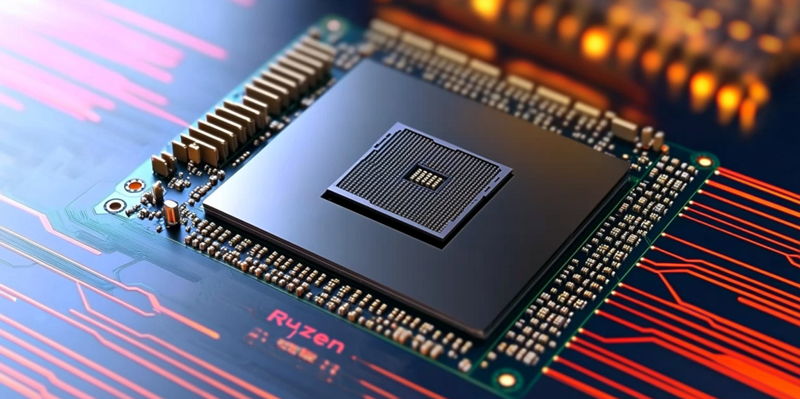AMD has officially announced the Ryzen 7 9800X3D, a new processor that promises to deliver enhanced gaming performance. This announcement follows a series of leaks and speculations about the processor’s features and performance improvements. The Ryzen 7 9800X3D is set to make a significant impact in the CPU market, particularly for gamers and tech enthusiasts.
Specifications and Features
Core and Thread Configuration
The Ryzen 7 9800X3D is equipped with 8 cores and 16 threads, operating at a base clock speed of 4.7GHz, which can boost up to 5.2GHz. This configuration is designed to handle intensive computational tasks and provide a smooth gaming experience. The processor’s architecture leverages AMD’s second-generation 3D V-Cache technology, which places the cache beneath the Core Complex Die (CCD). This structural change brings the cores closer to the cooling solution, potentially enabling faster clock speeds by maintaining lower thermal output.
Pricing and Market Positioning
AMD has strategically priced the Ryzen 9800X3D at $479, a noticeable $30 increase over its predecessor, the 7800X3D. This pricing strategy suggests confidence in the product’s improved performance and market reception capacity. The $30 increase might not be significant, but it will be crucial for AMD to meet performance expectations convincingly to justify this hike. Comparatively, some consumers could feel regretful for not capitalizing on previous deals for the 7800X3D, which had dropped to just over $300 during sales.
Performance Evaluations
Gaming Performance
AMD claims that the Ryzen 7 9800X3D provides an average gaming performance improvement of 8% over the 7800X3D, tested using a suite of over 40 popular PC games. In certain titles, notably Star Wars Outlaws, users might experience double-digit performance gains. This focus on gaming performance underscores the processor’s target demographic and intended primary use case. By highlighting performance boosts in gaming scenarios and ensuring better minimum frame rates, AMD aims to attract gamers looking for seamless and immersive gaming experiences.
Comparison with Intel’s Offerings
When compared to Intel’s latest flagship, the Intel Core Ultra 9 285K, the Ryzen 9800X3D purportedly delivers up to 20% better performance on average, considering both standard and peak usage scenarios. A key highlight of the 9800X3D is its unlocked state, facilitating overclocking endeavors for enthusiasts who seek to push the hardware beyond its standard performance parameters. With a thermal design power (TDP) of 120 watts and an impressive total cache of 104MB (64MB being the 3D V-Cache), the processor stands out as a powerhouse for gaming and potentially other intensive computational tasks.
Technological Advancements
Second-Generation 3D V-Cache
The second-generation 3D V-Cache is a significant technical evolution staking AMD’s claim as a leader in innovative CPU design. This technology’s emphasis on thermal efficiency and proximity of cache to cores exemplifies AMD’s investment in advancing processor architecture. The design leverages a second-generation 3D V-Cache technology, where the cache is situated beneath the Core Complex Die (CCD). This structural change brings the cores closer to the cooling solution, potentially enabling faster clock speeds by maintaining lower thermal output.
Overclocking Capabilities
A key highlight of the 9800X3D is its unlocked state, facilitating overclocking endeavors for enthusiasts who seek to push the hardware beyond its standard performance parameters. This feature is particularly appealing to tech enthusiasts who enjoy customizing and optimizing their systems for maximum performance. The processor’s thermal design power (TDP) of 120 watts and an impressive total cache of 104MB (64MB being the 3D V-Cache) further enhance its appeal as a high-performance component.
Market Reception and Future Prospects
Consumer Expectations
Despite the moderately higher price, if the Ryzen 9800X3D meets its performance claims in independent tests, it could solidify AMD’s competitive stance against Intel in the CPU market. Notably, given the challenges Intel’s Arrow Lake series has faced with gaming, AMD’s new processor might secure a favorable position in this domain. The $30 increase in MSRP from the previous generation might not be significant, but it will be crucial for AMD to meet performance expectations convincingly to justify this hike.
Strategic Positioning
AMD has officially unveiled the Ryzen 7 9800X3D, a next-gen processor designed to significantly elevate gaming performance. This much-anticipated announcement follows a period teeming with leaks and speculation about the processor’s advanced features and potential performance boosts. The buzz surrounding the Ryzen 7 9800X3D has captivated gamers and tech aficionados alike, who have been eagerly awaiting details on how this new CPU will stack up against current market offerings.
The Ryzen 7 9800X3D builds upon AMD’s reputation for innovation, promising to bring forth enhanced speed and efficiency that could redefine gaming standards. It’s expected to compete fiercely with other top-tier processors, projecting AMD further into the spotlight within the competitive tech industry. With its cutting-edge technology, the Ryzen 7 9800X3D represents a compelling option for anyone looking to upgrade their gaming setup or stay ahead in the fast-paced world of computing. This move is poised to solidify AMD’s standing as a dominant force in the CPU market, particularly among gamers and tech enthusiasts.

